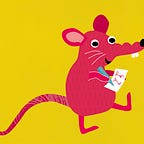Entangled Up in Blue
Quantum physics reeks with strange terms, most, no pretty much all of them, incomprehensible to me. (In fact, strange is one of them.) My lack of knowledge about this particular science, better known as quantupidity, makes it difficult to follow along when I stumble across articles in places like Scientific American. So, why, you might be thinking, don’t I just turn the page quickly or click away from things that make my brain cry out for respite? Because I get sucked in by the titles, ones that intrigue and entice while disguising the bottomless rabbit holes that lurk behind them. In this case the title is “Photons, Quasars and the Possibility of Free Will.” Written by Brian Koberlein, it promised to explain why “flickers of light from the edge of the cosmos help physicists advance the idea that the future is not predetermined.”
Brian begins this way:
Life is full of choices. Do we have a cookie or go to the gym? Do we binge watch our favorite show on Netflix or go to bed at a reasonable time? Our choices have consequences, and we make them of our own free will. Or do we?
He then skips over the philosophical tussles over the nature of free will to make this observation:
It [free will] also raises the question about the fundamental nature of the universe. Is the cosmos governed by strict physical laws that determine its fate from the big bang until the end of time? Or do the laws of nature sometimes allow for things to happen at random?
He then reveals that “a new experiment has tilted the odds toward the latter by performing a quantum experiment across billions of light-years.”
Here is where my brain begins to wobble, much like a car with the front end out of alignment will start to shake, rattle, and roll when a certain speed is reached. The experiment Brian references is the Einstein-Podolsky-Rosen thought experiment, or EPR for short:
To understand the experiment, suppose we have a mischievous mutual friend named Jane. Whenever Jane wears out a pair of running shoes, she loves to prank us by sending one shoe to each of us. So, whenever you get a shoe in the mail from Jane, you know I’ve gotten one too. One of us gets the right shoe, the other the left. But until either of us open our respective box, neither of us know which shoe we have. Once the box arrives at your door, you open it up, and find you have the left shoe. At that moment, you know I must have the right shoe.
Brian then proceeds to put my gray matter into the Ninja Professional Plus and hit the “Liquefy” button:
In the quantum realm things can be in an indefinite state until you observe them. It would be as if our boxes contained a pair of something (gloves, shoes, salt and pepper shakers, etc.) but it is impossible to know what specific something until one of us opens their box. Even stranger, how we measure quantum objects determines what the outcome can be. It would be as if opening the box on the side forces it to be a glove, while opening it from the top forces it to be a shoe. How I open my box affects your box miles away. In quantum theory, we say that our two boxes are entangled, so that observing the content of one box also tells us something about the other.
With the mention of “entanglement,” my neurons start to leak out my ears. Brian goes on to explain how the EPR experiment uses random light from quasars to demonstrate that the universe may have some measure of randomness, or free will, to it. I’m stuck on trying to parse the E word, something Einstein described as “spooky action at a distance.”
Merriam-Webster defines entanglement as “the action of entangling” or “the state of being entangled.” Entangling means to “wrap or twist together.” So, in the quantum world I guess, objects such as photons can be somehow wrapped or twisted together such that a change in the state of one changes the state of the other, even if they are billions of light years apart.
Way? Or no way?! Fortunately, entangled also means being “involved in a perplexing or troublesome situation.” Both apply here. The best choice seems to acknowledge my massive quantupidity and take Brian at his word when he says this:
The result [of the EPR experiment] was just what quantum theory predicts. Thus, it looks like there really are no deterministic hidden variables, and randomness is still possible throughout the cosmos. Of course, randomness isn’t the only thing necessary for free will. But it does mean that your fate is not necessarily sealed. So, when you resist that second cookie, or turn off the TV in the evening, you can take pride in the fact that maybe, just maybe, the choice was yours after all.
Or, conversely, you can be ashamed when you don’t resist that second cookie or turn off the television. Since I’m not sure I could bear any more guilt than I already have, I am inventing a new quantum theory right here and now. In it, all positive actions are the result of free will and all negative actions are predetermined. That way when I resist that second cookie, I can pat myself on the back and feel good, and when I don’t resist it, I can avoid feeling bad by shrugging and assigning blame to the cosmological fickle finger of fate. I’m calling this construct, very fittingly I believe, the HYCAEIT* quantum theory.
*Have Your Cookie and Eat It Too
(Image: NASA photo of a quasar tsunami. Public domain.)
